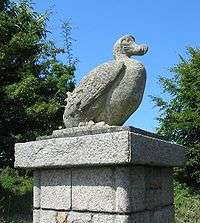Durrell Wildlife Park
|
The dodo is the symbol of the trust and the zoo. Statues of dodos stand at the zoo's gateways. | |
| Date opened | 26 March 1959 |
|---|---|
| Location | Trinity, Jersey |
| Coordinates | 49°13′46″N 2°04′24″W / 49.22949°N 2.07338°WCoordinates: 49°13′46″N 2°04′24″W / 49.22949°N 2.07338°W |
| Land area | 32 acres (13 ha)[1] |
| Number of animals | 1,400+[1] |
| Number of species | 130+[2] |
| Annual visitors | 169,000 (2009)[2] |
| Website |
www |
Durrell Wildlife Park (formerly Jersey Zoo[3]) is a zoological park established in 1959[2] on the island of Jersey in the English Channel by naturalist and author Gerald Durrell (1925–1995). It is operated by the Durrell Wildlife Conservation Trust. It has approximately 169,000 visitors per year, despite a lack of emphasis on large animals and its relatively out-of-the-way location; visitor numbers tend to vary with the tourist trade to Jersey.
Jersey Zoo has always concentrated on rare and endangered species. It has mammals, birds, amphibians and reptiles, comprising over 130 species.
Since 1964, the zoo has been home to the Durrell Wildlife Conservation Trust (formerly the Jersey Wildlife Preservation Trust).
Site
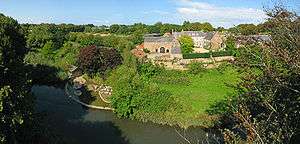
The park is located at Les Augrès Manor, Trinity, Jersey, 5 miles (8.0 km) north of Saint Helier. It officially opened on 26 March 1959.[2]
The park is situated in 32 acres (13 ha) of landscaped parkland and water-gardens. The Trust has a strong commitment to looking after the Island's native wildlife, and large areas within the grounds have been designated native habitat areas. The extensive planting of flowering and fruiting trees throughout the grounds also serves to attract a plethora of wild birds and insects. Included in the former are several species of bird which used to be commonly seen in island gardens but have become increasingly scarce, including the house sparrow and song thrush.
There are over 50 nest-boxes positioned around the grounds, which are used by a variety of birds including barn owls, kestrels, swallows and martins. Other animals which are commonly seen within the grounds are the red squirrel, bank vole, and the short-toed treecreeper.
History
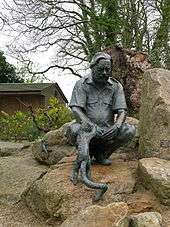
Gerald Durrell began his career capturing animals for other zoos, but thought that the facilities needed to concentrate more on animal conservation rather than mere entertainment. He tells the story of starting the zoo in his book "Menagerie Manor" and others.
In January 2008 plans, known as "New Vision," were unveiled for the future of the zoo. They were brought up to help ensure another 50 years of the trust in Jersey. These ambitious plans had an emphasis on the notion of 'TopSpots'; places where the greatest diversity of animals are found such as islands and highlands. It was budgeted that the cost of the redevelopment would be in the region of £46 million over the next five years. All funds needed to be raised through public and private donations. There were nine main aspects of development with animal welfare in its mind. Most of the plan was eventually cancelled due to costs.
- African Bai — The idea was to recreate an environment mirroring the ecology of the African habitat, that the western lowland gorillas would need to adapt to, if one day it would be safe for them to be left alone in the wild. The multimillion-pound complex would include a gym and updated facilities for the gorillas. The family size could expand, or have an additional group to live alongside the current group. With the African Bai theme, it was planned to bring in new species from the region, considered animals included red river hog, African clawless otter, and guenon monkeys.
- Mascarenia — The idea was to integrate the mammals, birds and terrapins of Madagascar together in one walkthrough enclosure. It is also possible that species from Mauritius, Comores and Seychelles might be included. Surrounding the walkthrough area, which would include the bats, were enclosures which would house the lemurs, aye-ayes, narrow-striped mongoose and Malagasy giant rats.
- A new visitor centre, which was designed to enhance the guests overall experience. A restaurant, and a hall of fame would become part of the experience.
- Eco-lodge cabins, which would allow people to stay at Durrell for a holiday, all environmental modern experience
- New Reptile and Amphibian Centre, which would allow Durrell to expand and enhance the care for species more prone to the changing environment
- Redevelopment of Les Augres manor, which would allow people to stay there for holidays, by turning part into a kind of hotel
- Improvements to training facilities
- Improvements to the centres
- Develop the Royal Pavilion into a full-time conference suite
In May 2011, a new visitor centre and restaurant was officially opened by Princess Anne.[4] Access to the zoo is not required for access to the restaurant. A webcam service has been recently developed at Durrell Wildlife Park. Cameras have been installed in the meerkat enclosure, as well as in those of the Telfair's skinks, the Livingstone's fruit bats and in the Kirindy Forest, the home of a rare and colourful bird collection. The webcam lets viewers to those species at times when they are often inaccessible, including watching the fruit bats during the evening when they are most active. In 2015 an infant silverback gorilla named Indigo who lived at the park was chosen to be the mascot of the 2015 Island Games which were held on the island.[5]
Exhibits
Jewels of the Forest
Opened in 2004, this exhibit houses various Asian birds such as:
- Palawan peacock-pheasant
- Blue-crowned laughingthrush
- Red-tailed laughingthrush
- White-rumped shama
- Nicobar pigeon
- Emerald dove
- Mindanao bleeding-heart dove
- Java sparrow
- Pekin robin
- Hooded pitta
- Chestnut-backed thrush
- Asian fairy-bluebird
- Grey-faced liocichla
Cloud Forest
Opened in 1999, the Cloud Forest is the first enclosure at Durrell to feature mixed animals, including carnivorous species.
- Andean bear
- Ring-tailed coati
- Black howler monkey
- Brazilian tanager
- Orange-bellied euphonia
- Red-cowled cardinal
- Silver-throated tanager
Princess Royal Pavilion
The Pavilion was opened by HRH Princess Anne in the 1970s, and serves as a conference centre, and classroom. The theatre shows films depicting the work of the trust, and also exhibits artwork. It highlights the work undertaken by the Trust around the world.
The Pavilion also houses a number of species which are used for educational aspect of conservation. They include corn snakes, rainbow boas, milk snakes, New Guinea blue-tongued skinks, giant African land snails, giant millipedes, Madagascar hissing cockroaches, and Macleays spectre, a large stick insect.
The Gaherty Reptile and Amphibian Centre
The reptile house is the home of many species of reptiles and amphibians. The Gaherty Reptile and Amphibian Centre was so named because of a gift from Canadian philanthropist Geoff Gaherty.
- Reptiles
- Burmese python
- Radiated tortoise
- Galapagos giant tortoise
- Flat-backed spider tortoise
- Lesser Antillean iguana
- Komodo dragon
- Round Island skink
- Spiny turtle
- Panther chameleon
- Rio Fuerte beaded lizard
- Lesser night gecko
- Martinique's anole
- Serrated casquehead iguana
- European adder
- Amphibians
- Strawberry poison-dart frog
- Blue poison dart frog
- Golden poison dart frog
- Mountain chicken
- Mission golden-eyed tree frog
- Jersey agile frog
- Alien Invaders
One issue which Durrell highlights is the effect of what happens when a non-native species is introduced to an environment and the damaging effect they can have. Case examples in the park include
Discovery Desert
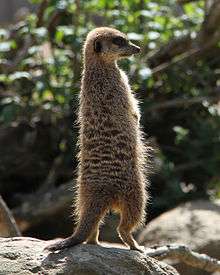
The Discovery Desert was opened in April 2009, and was designed to give the family of meerkats more room to roam, and ensure they don't dig for freedom. Discovery desert is a mixed species exhibit featuring other animals which share the meerkat's habitat in the wild, and pose no threat to each other, such as the yellow mongoose.
Gorillas
The western lowland gorilla family has been represented at Durrell since it first opened in 1959, when they had only an infant female gorilla named N'Pongo, who was later joined by a younger infant female gorilla named Nandi, and continue today to be one of the icons of the park. The current enclosure includes a good sized outdoor play area, and three internal rooms, two large on-show ones and a smaller off-show one. The current family of five is led by a silverback called Badongo, who was born in Les Valles des singes. Badongo is the successor of Ya Kwanza. The remaining members of the family are female. From the Jambo era, are Kishka, and Kahilli, (Jambo x N'Pongo). There is also a young female named Bahasha. Kahilli has had two offspring from Ya Kwanza, a male named Mapema, and a female named Ya Pili. In 2007 the family suffered the loss of the youngest gorilla Ya Pili. The other three females did not bred with Ya Kwanza.
One of the plans for the future is a new larger gorilla complex, allowing for a larger family, top rated facilities and a chance to start familiarising the species with others they would come across in the wild such as the red river hog.
- Jambo
Jambo was a gorilla who was born in 1961, in the Zoo Basel, Switzerland. Jambo shot to international news stardom overnight on 31 August 1986, when five-year-old Levan Merritt fell into the gorilla enclosure and lost consciousness. Jambo stood guard over the boy when he was unconscious, placing himself between the boy and other gorillas in what ethnologists analyze as a protective gesture. He later stroked the unconscious boy. When the boy regained consciousness and started to cry, Jambo and the other gorillas retreated, and an ambulance paramedic and two keepers rescued the boy. Most of the drama was shot on home video by Brian Le Lion, and extensively photographed by other zoo visitors. The publicity on major news channels and newspapers helped the reputations of gorillas.
Red river hogs
Red river hogs were introduced to the zoo in August 2009, when two sows were transferred from Whipsnade. They have a brand new enclosure built by zoo volunteers, with a viewing platform in which to view them. The trust aim to highlight issue of the illegal trade of bushmeat in Africa, which also affects other species such as gorillas. A breeding programme was started in 2011 with the arrival of the boar hog.
Tamarins and marmosets
The tamarins are kept in two areas of the park, some such as the golden lion and emperor tamarins are best kept within their own enclosures. Meanwhile, others such as the black lion tamarin and the silvery marmoset are allowed to run free in a small wooded area which helps them thrive.
- Silvery marmoset
- Goeldi's monkey
- Golden lion tamarin
- Golden-headed lion tamarin
- Emperor tamarin
- Black lion tamarin
- Pied tamarin
Central Valley
The Central Valley, expands across the centre of the park, creating a natural barrier and water resource for local species. A £1 million project to redevelop the central valley, completed in 2002, has created a haven for kingfishers, bank voles, butterflies, dragonflies, and several species of waterfowl. During the valley restoration two species of locally rare orchid were encouraged, and first flowered in 2005. They are Anacamptis laxiflora and southern marsh orchid.
- Oriental small-clawed otter
- Red-breasted goose
- Chilean flamingo
- Grey crowned crane
- Greater flamingo
- Swan goose
- White-naped crane
- Blue crane
- Red-billed chough
- The red-billed chough became extinct on Jersey in the nineteenth century, but they have once again returned. Durrell has joined a breeding programme and so a group are being kept at Durrell to form a captive colony, with hope to establish a free flying colony in the Trust's grounds.
Aviaries
Dotted around the Central Valley are a number of aviaries which house a selection of birds from different parts of the world. The aviaries are specialised to reflect habitat the birds should become adapted to should they be released back into the wild. They are large enough for them to fly short distances, or search the ground for food.
- Northern bald ibis
- Congo peafowl
- Edward's pheasant
- Vietnamese pheasant
- Red-crested turaco
- St. Lucia amazon
- Bali starling
- Pink pigeon
- Echo parakeet
- Black bulbul
- Montserrat oriole
- Wrinkled hornbill
- White-crowned robin-chat
- Indonesian teal
- Tropical mockingbird
Orangutans and gibbons
In an enclosure which was revamped in the 1990s the orang utans have a large outdoor play area for them to swing around. The enclosure consists of one large main house, with two extensive external islands surrounded by a moat. The orangutan family have been in Durrell since 1968, and come from Sumatra. Durrell used to have the Bornean orangutans, until it was decided that Durrell should focus on the rarest when the redevelopment took place. There are currently seven orangutans at Durell; The dominant male is called Dagu. The three adult females are, Gina and an unrelated female called Dana. The three offspring are Mawar's eldest son Jiwa and Gina's youngest son, Jaya. Sharing the island play areas is a pair of lar gibbons, George who is black and Hazel who is light brown.
Macaques
Since 1964 Durrell have been working with the macaque family, in the same location, just to the side of the valley. The family have bred well, though events in Sulawesi counterbalance the work in Durrell.
Maned wolves
The maned wolves have been in Durrell since 2001, having replaced the Przewalski's horses. Currently there are no wolves.
Teal Aviary
Lemurs
Durrell is the home to six species of lemur. Five species (excluding the red-fronted brown lemurs which are solely in Kirindy Forest) are dotted around the grounds and some form the vocal point of the Madagascan exhibit Kirindy Forest.
- Ring-tailed lemur
- Black-and-white ruffed lemur
- Red ruffed lemur
- Alaotran gentle lemur
- Aye-aye
- Red-fronted brown lemur
Bat tunnel
A large polytunnel which has been built with used tyres was completed in spring 2011. It is the new home of the two species of bat found in Durrell. The new polytunnel is located near the organic farm and apple orchard.
Kirindy Forest
A major renovation project was to transform the Walled Gardens into an area marked Kirindy Forest. Based on the dry forests of Madagascar, the area is designed to showcase the work being done with the native species. There are new homes for the aye-ayes, giant jumping rats and mongooses, and a new walkthrough aviary.
- Ring-tailed lemur
- Red-fronted brown lemur
- Aye-aye
- Narrow-striped mongoose
- Malagasy giant rat
- Madagascar teal
- Black-winged stilt
- White-backed duck
- White-faced whistling duck
- African pygmy goose
- Madagascar turtle dove
- Madagascar crested ibis
- Red fody
- Hammerkop
Conservation successes
Proof that conservation does work, some species have returned home for continuation of programmes to reintroduce them to their own environment
In 1976 there were only four individuals in the wild with one female. Durrell took the risk of taking a recent clutch of eggs and had them hatched successfully – rebuilding the species, almost from scratch. The conservation for the species has moved on to the next stage and its focus has returned to Mauritius, re-establishing the species in the community and ecosystem.
With the newly established wild population of these species, originally extinct from the wild the zoo was part of the coalition of 'zoos' which together brought the species from the brink of extinction.
Work in Jersey
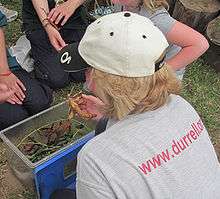
Helping the local species Durrell is also working closely with local wildlife groups to help with the declining populations of Jersey's sand lizard, the Jersey crapaud / common toad, and Jersey's agile frog
- Local rare and declining plant propagation
A long way from the usual animal conservation work at Durrell. Aim is maintain the genetic diversity of the locally rare plants. Currently four species are being grown in the propagation unit. Fragaria vesca (wild strawberry), Dianthus gallicus (Jersey pink), Anogramma leptophylla (Jersey fern) and Linaria vulgaris (common toadflax). Other plant species will be propagated as seed or cutting material becomes available. As some of these plant species are so severely threatened, just finding specimens for propagation will be a real challenge.
- Bird Reintroductions
In 2010 Durrell have undertaken a project to reintroduce birds that once populated the islands clifftops, that have long disappeared from the island. The red-billed chough is the first focus of the programme, and they can now be found in the central valley area. There are also potential plans to do something similar with the yellowhammer should the project prove successful.
Durrell overseas
- Although no longer located in Jersey, conservation is still monitored by Durrell in Assam India and other locations. The species is still in dire need of funding and help. During 2008 some pygmy hogs were released into the wild in Assam, early reports show good progress with the species
- Hitting headlines recently is some success in Grand Cayman with the blue iguana. Working alongside local authorities the iguana is being saved from extinction. It shows what can be done. In 2008 the project suffered a drawback when intruders broke into the complex and killed numerous iguanas, including juveniles and expecting females.
- Previously thought extinct, (found when looking for something else), Durrell have recently teamed up with Madagascar to help research and study the species. With scouts unable to locate more individuals, it has become a possibility that experts will have to bring the survivors back to Jersey, using expertise from the Madagascar teal and Meller's duck to help the duck get back from the brink
- In 1995 was dubbed the world's rarest snake. More recently the species have been relocated back to Antigua on some islands where they are free from predators and pests.
- Mauritius olive white-eye
- White-footed tamarin
- Ploughshare tortoise
- Round Island day gecko
- Round Island skink
- Round Island boa
- Mangrove finch
- Mauritius fody
- Giant hispaniolan galliwasp
- Cuban solenodon
- Floreana mockingbird
- Hispaniolan hutia
- Hispaniolan solenodon
- Mountain coati
Completed programmes
- Partula snails
- Rhinoceros iguana 1974–2010
- African crested porcupine
- White-headed marmoset
- Cuvier's dwarf caiman
- Cottontop tamarin 1972–2009
- Parma wallaby 1959–2008
- Trinidad stream frog
- Green and black poison dart frog
- Standing's day gecko
- Plumed basilisk
- Snow leopard
- Cheetah
- Babirusa
- Snowy owl
- White-eared pheasant
- Bornean orangutan
- Serval
- Volcano rabbit
- Chimpanzee
- African lion
- Brazilian tapir
- Leopards
- Peccaries
- Macaws
- Porcupines
- Humboldt penguin
- African elephant
Durrell Wildlife Camp
Work began on the Durrell Wildlife Camp[6] in early 2012, which will allow the park to sell lodging and services to visitors.
A wooded copse to the west of Les Augrès Manor has been landscaped to provide a nine-metre-square level wooden deck roughly every seven metres. These decks will house twelve geodesic dome-shaped, semi permanent tent structures and a separate shower and toilet cubicle for each. A further two platforms will house a communal structure and a pod for health and beauty treatments.
Durrell Wildlife Camp is described as a 'glamorous camping' resort. The site has WiFi coverage, and each pod has a hard-wired electrical feed for running AC 240 V appliances. This sets it outside the remit of camping despite the use of tents as opposed to permanent buildings.
References
- 1 2 "Durrell Wildlife Conservation Trust". jersey.com. Jersey.com. Retrieved 26 May 2012.
- 1 2 3 4 "Durrell Wildlife Conservation Trust: Press Information" (PDF). Retrieved 26 May 2012.
- ↑ A day at the Zoo
- ↑ The Princess Royal visits Jersey
- ↑ Indigo's page on the Island Games 2015 website
- ↑ Durrell Wildlife Camp
External links
| Wikimedia Commons has media related to Durrell Wildlife Park. |
